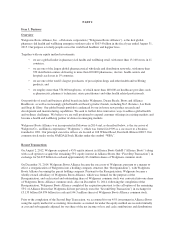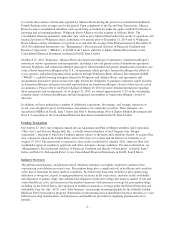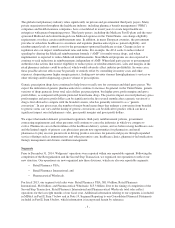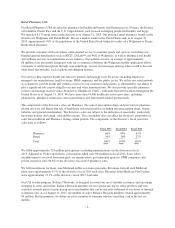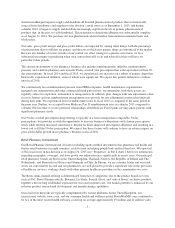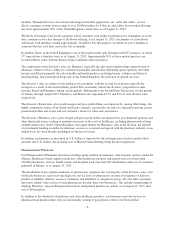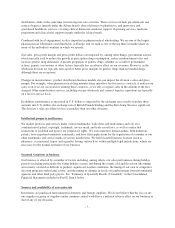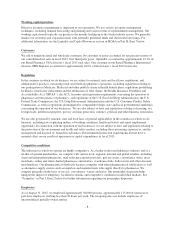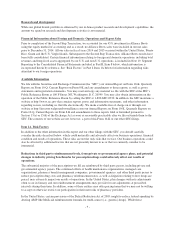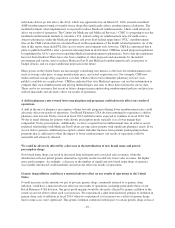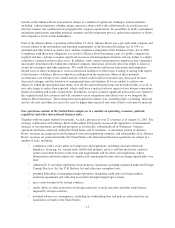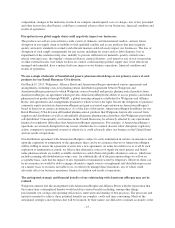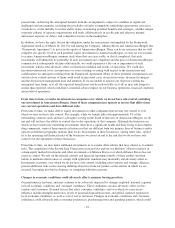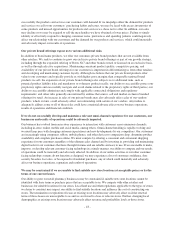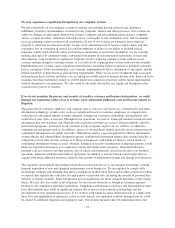Walgreens 2015 Annual Report Download - page 15
Download and view the complete annual report
Please find page 15 of the 2015 Walgreens annual report below. You can navigate through the pages in the report by either clicking on the pages listed below, or by using the keyword search tool below to find specific information within the annual report.2015. Any failure to fully offset any such increased prices and costs or to modify our activities to mitigate the
impact could have a material adverse effect on our results of operations.
We derive a significant portion of our sales in the United States from prescription drug sales reimbursed
by pharmacy benefit management companies.
We derive a significant portion of our sales in the United States from prescription drug sales reimbursed through
prescription drug plans administered by PBM companies. PBM companies typically administer multiple
prescription drug plans that expire at various times and provide for varying reimbursement rates, and often limit
coverage to specific drug products on an approved list, known as a formulary, which might not include all of the
approved drugs for a particular indication. There can be no assurance that we will continue to participate in any
particular PBM company’s pharmacy provider network in any particular future time period. If our participation
in the pharmacy provider network for a prescription drug plan administered by one or more of the large PBM
companies is restricted or terminated, we expect that our sales would be adversely affected, at least in the
short-term. If we are unable to replace any such lost sales, either through an increase in other sales or through a
resumption of participation in those plans, our operating results could be materially and adversely affected. If we
exit a pharmacy provider network and later resume participation, there can be no assurance that we will achieve
any particular level of business on any particular pace, or that all clients of the PBM company will choose to
include us again in the pharmacy network for their plans, initially or at all. In addition, in such circumstances we
may incur increased marketing and other costs in connection with initiatives to regain former patients and attract
new patients covered by such plans.
Consolidation and strategic alliances in the healthcare industry could adversely affect our business
operations, competitive positioning, financial condition and results of operations.
Many organizations in the healthcare industry, including PBM companies and health insurance companies, have
consolidated in recent years to create larger healthcare enterprises with greater bargaining power, which has
resulted in greater pricing pressures. For example, in July 2015, OptumRx, UnitedHealth Group’s pharmacy care
services business, completed its combination with Catamaran Corporation, with the combined businesses
expected to fulfill over one billion prescriptions in 2015 and be the third largest PBM company in the United
States. In addition, significant business combinations within the health insurance industry were announced in
July 2015, with Anthem, Inc. announcing its agreement to acquire Cigna Corporation, and Aetna, Inc.
announcing its agreement to acquire Humana Inc., with the resulting enterprises expected to be two of the three
largest health insurers in the United States. If this consolidation trend continues, it could give the resulting
enterprises even greater bargaining power, which may lead to further pressure on the prices for our products and
services. If these pressures result in reductions in our prices, our businesses would become less profitable unless
we are able to achieve corresponding reductions in costs.
Strategic alliances in the healthcare industry also impact our businesses and competitive positioning. For
example, following the announcement of our agreement with AmerisourceBergen providing for, among other
things, generic drug purchasing by Walgreens, Alliance Boots and AmerisourceBergen through WBAD, our
global sourcing enterprise, some of our retail pharmacy competitors subsequently established relationships with
other pharmaceutical drug wholesalers relating to generic drug procurement. In addition, further consolidation
among generic drug manufacturers could lead to increased generic drug inflation in the future. We expect that
market demand, government regulation, third-party reimbursement policies, government contracting
requirements, and other pressures will continue to cause the healthcare industry to evolve, potentially resulting in
further business consolidations and alliances among the industry participants we engage with, and which may
materially and adversely impact our business operations, financial condition and results of operations.
We may not be able to successfully or timely complete the pending acquisition of Rite Aid.
Risks and uncertainties related to our pending acquisition of Rite Aid include, among others: the occurrence of
any event, change or other circumstance that could give rise to the termination of the Merger Agreement
-11-


